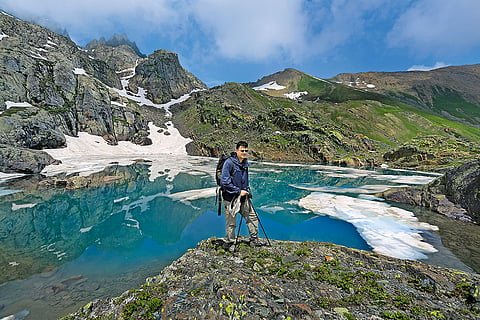

For a man passionate about mountains, Mahmood Ahmed Shah couldn't have been born in a better place. Growing up in Kashmir, Shah spent hours gazing at the mountains in the distance, dreaming of someday exploring the mighty peaks that filled his soul with intrigue and wanderlust.
Today, as Director of Industries and Commerce and Handicrafts and Handloom, Kashmir, Shah is a busy and respected bureaucrat; however, his governmental duties haven't stopped him from pursuing his passion. He has the distinction of exploring 112 Alpine lakes in the region and circumambulation of the entire Kashmir Valley. He also happens to be a patron of the Jammu and Kashmir Mountaineering and Adventure Club, established in 1934, and will soon publish a coffee table book on the valleys of Kashmir. We caught up with him to learn more about his journeys.
What made you undertake your first trek? What was the experience like?
I went on my first trek in 1989 to the Amarnath Cave but needed to prepare better for it. I didn't have the right gear or shoes, so it was challenging, and I had to abandon the journey midway and return. But it was a learning experience, and I came back with a better understanding of the challenges the mountains offered. Soon after, militancy erupted in the valley, and I couldn't do much for the next 12-13 years. During that time, however, I found comfort in books. I read travelogues written by European authors on Kashmir, and they were a treasure trove of knowledge.
What has been your most special trek to date? Can you share a few memorable anecdotes about it?
I did a trek, which starts from Padam, the headquarters of Zanskar. From there, you go to a Gompa called Dzongkhul. From Dzongkhul, you begin the trail, which goes over a pass called Umasila, one of the highest at about 5,400 metres, that goes all the way down to a place called Gulabgarh in Kishtwar. This trail offers fantastic experiences from the barren landscape of Ladakh to the thickly forested areas of Kishtwar. And it's not just the scenery that changes; the culture, language, climate, and even religion changes from Buddhist-dominated regions to predominantly Hindu villages to the Muslim habitations of Kishtwar. So, it is one of the truly unique trails where you see the incredible diversity of the Himalayas.
Do you have any memories of interesting people you met on these explorations?
My interactions with the locals have always been memorable. In Kashmir and Ladakh, people go to the highlands to graze their cattle. When you trek these high-altitude passes, meadows and peaks, you come across these people living in small structures. They are hospitable and have always helped us with food, shelter, and supplies. In return, they usually ask for medicines. There are incredible, hardy people in the mountains with big hearts.
Please share anecdotes about risky situations that you faced.
The cattle herders employ dogs to protect their herds, who are very protective of their territory and can be dangerous. Once, I was photographing a high-altitude lake early in the morning when three dogs attacked me. Had I run away and not stood my ground, I would have been badly injured. Since then, I have never ventured alone into the mountains and always carry a stick or an ice axe for protection. On many occasions, I have seen bears, leopards and snakes, but they are not very aggressive, other than black bears.
What fresh adventure are you planning to set off on next?
After doing 112 lakes, many passes and trails, I want to chart a new set of routes for posterity for the next generation so they can enjoy the beauty and the solitude of the mountains. There is an ingress of roads in the mountains, and the trekking routes are getting shorter, so creating these new trails is essential.
How can high-altitude trekking trails in Kashmir be made more accessible to tourists without compromising the region's fragile ecology?
Currently, 90 per cent of the treks in Kashmir happen in the Great Lakes region and the Tarsar-Marsar axis. We must also divert some traffic to the other trails to protect them from overtourism. And there is no trail shortage; we have thousands of lakes, meadows and passes. And the best thing about Kashmir is that when the trekking in the rest of the country stops because of the monsoons, it begins here.
